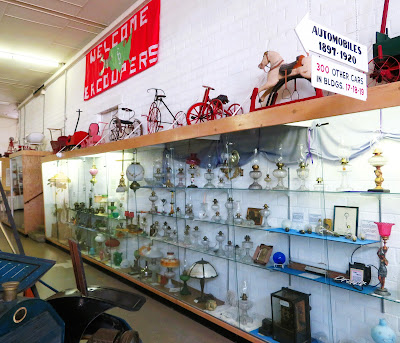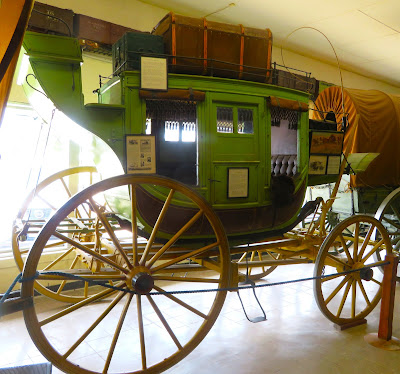…after completing our partial exploration of Missouri, we finally arrived at the family’s home in Omaha Nebraska. But…it wasn’t long before David II, David III, Laurie and yours truly loaded into a vehicle and headed west on US Hwy I-40 until we reached NE Hwy 10 and drove 13 miles south to the town of Minden.
This
little jaunt covered 179 miles one way and took 2 hours and 40 minutes. So…what was the attraction that led to this
day long road trip?
Located
on US Hwy 6 in Minden, Pioneer Village was founded 70 years ago (1953) by
Harold Warp (1903 – 1994) was a successful manufacturer and former resident of
the town. Pioneer Village is a complex
of 28 buildings on 20 acres. Not
counting the items in storage, the collection includes over 50,000 items dating
from about 1830 to recent times.
So who was Harold Warp? (I love that first photo!) He was born in a sod house on a farm near Minden and he was the youngest of 12 children. His family had emigrated from Norway to the United States. His father died when Harold was only 3 and his mother died when he was 11 years old. In 1924, he and 2 of his brothers moved to Chicago with a patent for a plastic window material that he’d developed for the family’s chicken coops. The business was successful and the product line grew to include many other related items.
Warp
Bros. is still in business and it remains under family ownership. The company makes plastic products ranging
from shelf liners to storage bags to greenhouse films, landscaping sheets and
more.
Laurie
and I love to collect things…most of which we don’t need but enjoy having…but
Harold Warp was apparently a compulsive collector who appreciated American history,
and he had the funds to support his hobby!
By 1948,
Harold was a millionaire. He’d returned
to Minden for Christmas and he learned that the old schoolhouse that he and his
siblings had attended was to be sold at auction. He bought it after ensuring that all school
records would be preserved too. Then,
when the first church in town was to be disposed of, he bought it! Then
came the old Burlington and Missouri River Railroad Depot followed by the
original U.S. Government Land Office, the Elm Creek/Native American Fort, the
Bridgeport Pony Express Station and much, much more. So it began!
It is important to note that Pioneer Village is not the Smithsonian with lots of viewing area, space between exhibits and polished marble floors. It is a collection with items sometimes juxtaposed near other items that don’t seem related. One factor is generally true. Exhibits tend to progress from the early related items to the most recent. The goal is to show progress.
Of
course, the very first item I photographed was this 1964 Mazda “NSU Rotary
Spider” was the first Wankel powered car in Wisconsin and possibly the first
one in the USA. Mazda built about 2,00o
Spiders in total. To learn more about
the Wankel engines (no pistons), go to Wankel engine - Wikipedia.
Of course, the next photo I took was of this wall of oil lamps, lightbulbs, wagons, tricycles, toys, lamps and more. Did I mention that Harold Warp collected just about anything from 1830 on!? Also, did you note the 2 signs in the upper right hand corner of this photo?
From the
showcases shown above, we moved into a date progressive and themed area of
Pioneer Village.
This ox-cart actually pre-dates most of the items on display at Pioneer Village. It was built by Artimes Waterman in Deansboro New York back in 1822. The wide steel wheels were designed to keep the cart from sinking into hay meadows. Artimes’ grandson sold this 201 year old ox-cart to Harold Warp in 1954.
The museum has a number of buggies on display. By 1840 they’d evolved from the stage coach, only smaller and lighter and pulled by a single horse. For the first decade or so, only well-to-do families could afford them but within a decade they were in general use. Both stage coaches and buggies have a similar shape to them and both used leather springs. The yellow buggy in the second photo was made ca. 1840 in Sturbridge Massachusetts.
There is so much to see in a limited space! This conveyance isn’t a buggy, but rather a carriage. Larger families couldn’t fit into a buggy and ca. 1880, these larger carriages appeared. They could be enclosed with curtains on the sides and had a ‘splash apron’ at the front for use during bad weather. Over a million carriages were sold from about 1880 through 1910.
Of course, my photos aren’t in order as I just kept turning and taking pictures of what was nearby on either side of the aisle. This handsome stage coach was used by the Walker and Frank Stagecoach Company on the route from Detroit Michigan to Chicago Illinois. The original cost of this coach was about $1,250.00.
Stage
coaches appeared on the scene in the USA ca. 1835. Pulled by 4 to 6 horse teams, they had a
chance to outrun Native American’s attacks.
The fares were relatively expensive.
For example, the cost for a passenger to take the stage from St. Joseph
Missouri to Denver Colorado was about $175.00.
Luggage weight limits aren’t a new thing. The weight limit for luggage on many stage
lines was 25 lbs.
From 1835
to 1885, roughly 100,000 stage coaches were in use. Stops or stations were located from 75 to 125
miles apart. In the mid-1800s, taking a
stagecoach from coast to coast would take almost 2 months…
Once again I’ve managed to learn something I didn’t know or, at this stage in my life, I’d just forgotten. This is a Freight or Conestoga wagon. It should not be confused with the Prairie Schooner or covered wagons used by most settlers who headed west in the 1800s.
In 1857
Henry and Clem Studebaker built their first 100 wagons of this type. It was used by freight companies to transport
supplies across the plains. The average
box length of a Conestoga wagon was 10 feet long by 4 feet wide. Side boards could be 4 feet high. Wagons could carry up to 12,000 lbs. of cargo
and the seams in the wagon boxes were caulked with tar to keep them from
leaking when crossing rivers. It took
from 6 to 10 oxen to pull a loaded Conestoga or Freight wagon.
How
important were these wagons to the nation’s growth and development? In the 1860s, just Russell, Majors and
Waddell freighting firm alone used 6,000 wagons and 75,000 oxen to move
products along the Oregon Trail.
FYI…Prairie
Schooners or covered wagons were lighter, less bulky and they could make a
tighter turn. Their boxes were 4 feet
wide and 8 feet long and side boards were typically 2 feet high. Covered wagons only required 2 to 6 oxen…with
most needed 2 or 4. Horses could pull
the wagons too, but settlers quickly learned that Native Americans really
valued horses and their use attracted unwanted attention to the ‘settlers’.
I failed to record the date or age of this “Talley-Ho” Coach. In the United States, “tally-ho” is sometimes used to describe a large coach or light passenger vehicle that lacks a roof or sides. They were usually used for sight-seeing.
By way of
example, in 1886 the Yellowstone Park Transportation Company had a fleet of
sight-seeing coaches. They transported
visitors and their luggage from the train depot to the hotel at Mammoth Hot
Springs in “Tally-Ho” stage coaches pulled by 6-horse teams. The “Grand Loop” tour through the park used
similar Yellowstone Observation Wagons with 4-horse teams.
This little locomotive is a wood-burning “Porter”. These locomotives were used by some railroads during the 1870s and 1880s. Wood was plentiful and coal wasn’t always available. The Porter locomotive was designed with the water supply tank surrounding the boiler right over the engine’s drive wheels. That provided extra traction at a time when trains went over hills rather than through them. That flared smokestack served as a spark arrestor to minimize the danger of forest tires. This particular Porter locomotive came from Canada.
FYI –
H.K. Porter, Inc. built light-duty locomotives in the USA beginning in
1866. They became the largest
manufacturer of industrial or light-duty locomotives, building almost 8,000 of
them before production ended in 1950.
This is an 1897 Milwaukee Steam Carriage built by the Milwaukee Automobile Company…one of the first ‘horseless carriages’ (automobiles). The owner paid $765.00 for this 4 HP car and then he drove it from Milwaukee Wisconsin to his home in Hastings Nebraska. He used it regularly until 1910 and then from time to time until 1928. It remained in the family until Pioneer Village acquired it in 1955.
FYI - Did
you know that buggy whips were carried in a socket next to the driver in early
autos/horseless carriages? They were
used to chase cows off the road and to keep barking dogs away from the wheels.
FYI –
Early autos used carbide lamps instead of headlights as batteries for the
storage and use of electricity hadn’t been perfected yet. Carbide lamps as simple and they burn
acetylene…which is created by the reaction of calcium carbide with water.
This is a rare 1906 Model K Ford. This big auto sported a 6-cylinder 40 HP engine and it sold for $2,800. In the same year, Ford introduced the Model N, a 4-cylinder 15 HP auto…that sold for $500. The idea was to determine whether ‘horseless carriages’ were just going to be a rich man’s toy or the working man’s necessity. In 1906 and 1907, a total of 150 Model K’s were sold…while 2,500 Model N’s were sold in 1906 alone! Decision made…and from this experiment the low cost Ford Model T was born.
That’s
enough for now… Just click on any of the photos to enlarge them.
Thanks
for stopping by for a visit!
Take
Care, Big Daddy Dave
















A road trip for 3 generations :-) That has got to be fun! The vintage cars are really nice, but I love those coaches even more..
ReplyDeleteLooks like your kind of place. I had a Mazda RX-7 with a Wankel engine.
ReplyDeleteI had to laugh when I saw the Porter locomotive...it's so cute, and definitely a work horse, but still, painted so pretty! I'd drool in that museum and I do wish that kind of place could also become a historic landmark...to keep the whole thing going!
ReplyDeleteEspero que hayas pasado bien tu cumpleaños. Linda exposición de carros. Me gusto la locomotora. Te mando un beso.
ReplyDelete